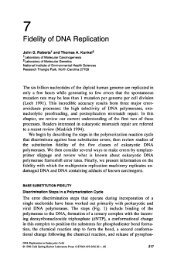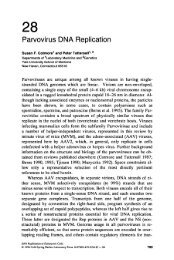Chapter 39: Mitochondrial DNA Replication (PDF)
Chapter 39: Mitochondrial DNA Replication (PDF)
Chapter 39: Mitochondrial DNA Replication (PDF)
You also want an ePaper? Increase the reach of your titles
YUMPU automatically turns print PDFs into web optimized ePapers that Google loves.
1022 D.A. Clayton<br />
priming or for transcripts that represent tRNAs or that encode a protein.<br />
Thus, the absence or impairment of function of these proteins should affect<br />
both mt<strong>DNA</strong> replication and gene expression. It is known that h-<br />
mtTFA is greatly reduced in some human tissues and cell lines with little<br />
or no mt<strong>DNA</strong> (Larsson et al. 1994; Poulton et al. 1994), but a direct loss<br />
of mt<strong>DNA</strong> due to down-regulation of h-mtTFA remains to be shown.<br />
The second important event in initiation appears to be the formation<br />
of stable RNA-<strong>DNA</strong> hybrids over the origin region (Fig. 2). The principal<br />
feature of mt<strong>DNA</strong> responsible for this is the highly conserved<br />
conserved sequence block I1 (CSBII) element. This short (usually<br />
defined as between 15 and 20 nucleotides) sequence is atypical in two<br />
obvious ways. It is not only more than 90% G+C-rich, but all of the<br />
guanosines are in one strand; RNA transcribed across CSBII thus contains<br />
this virtual guanosine homopolymer run. The requirements for<br />
stable RNA-<strong>DNA</strong> hybrid formation are clearest for yeast putative<br />
mt<strong>DNA</strong> origin sequences (Xu and Clayton 1995). The yeast CSBII sequence<br />
homolog is the necessary and sufficient element for sponsoring<br />
RNA-<strong>DNA</strong> hybrid formation, and the natural polarity of the sequences<br />
(guanosines in the RNA strand, cytosines in the <strong>DNA</strong> strand) must be<br />
maintained. The same basic phenomenon is seen for mammalian<br />
mt<strong>DNA</strong>, and in this case, CSBII is required along with some dependence<br />
on the two other conserved sequences at the origin, CSBIII and CSBI,<br />
with respect to efficiency of hybrid formation (Xu and Clayton 1996).<br />
Cleavage of D-loop region RNA-<strong>DNA</strong> hybrids has been achieved<br />
(D.Y. Lee and D.A. Clayton, unpubl.) with highly purified preparations<br />
of RNase MRP. These sites of cleavage align well with mapped termini<br />
of primer RNAs and nascent mt<strong>DNA</strong> 5’ ends at the leading-strand<br />
origin. Thus, a more refined model for initiation of leading-strand<br />
synthesis invokes stable RNA-<strong>DNA</strong> hybrid formation followed by R-<br />
loop processing to achieve synthesis by mt<strong>DNA</strong> polymerase (Fig. 3).<br />
COMPARING MAMMALIAN AND YEAST mt<strong>DNA</strong> REPLICATION<br />
Although the field of yeast mitochondrial biology and genetics has a<br />
longer history than that of mammalian studies, the molecular details of<br />
yeast mt<strong>DNA</strong> replication are largely unknown. This is due in part to the<br />
greater complexity of yeast mitochondrial genomes. In the case of wildtype<br />
mt<strong>DNA</strong>s, genome size is variable among strains and species. In<br />
cases where yeast mt<strong>DNA</strong> has been studied physically, it is apparent that<br />
the genome can be found in different circular and linear forms. This<br />
situation makes it difficult to perform the type of biochemical analyses






